Report: Growing Profitable Wheat Crop at Cunderdin SCIE3314
VerifiedAdded on 2023/06/03
|26
|6524
|364
Report
AI Summary
This report provides a comprehensive analysis of wheat crop management at the Cunderdin site, focusing on the key elements necessary for growing a profitable wheat crop. It begins with an introduction to the site, including its climate and soil analysis, comparing data from 2007 and 2017 to highlight changes in nutrient levels. The report then delves into wheat crop management, covering land preparation techniques, optimal planting times, irrigation requirements and scheduling, and various pest control methods, including viral, bacterial, and fungal diseases. It also discusses crop rotation, variety selection, seeding, basal fertilizer application, and nitrogen application strategies for yield prediction. The report includes a gross margin analysis to assess profitability and concludes with key recommendations. The assignment is designed to provide insights into the practical aspects of wheat farming, emphasizing the importance of site-specific management practices.

CROP AND CROPPING
By Name
Course
Instructor
Institution
Location
Date
By Name
Course
Instructor
Institution
Location
Date
Paraphrase This Document
Need a fresh take? Get an instant paraphrase of this document with our AI Paraphraser
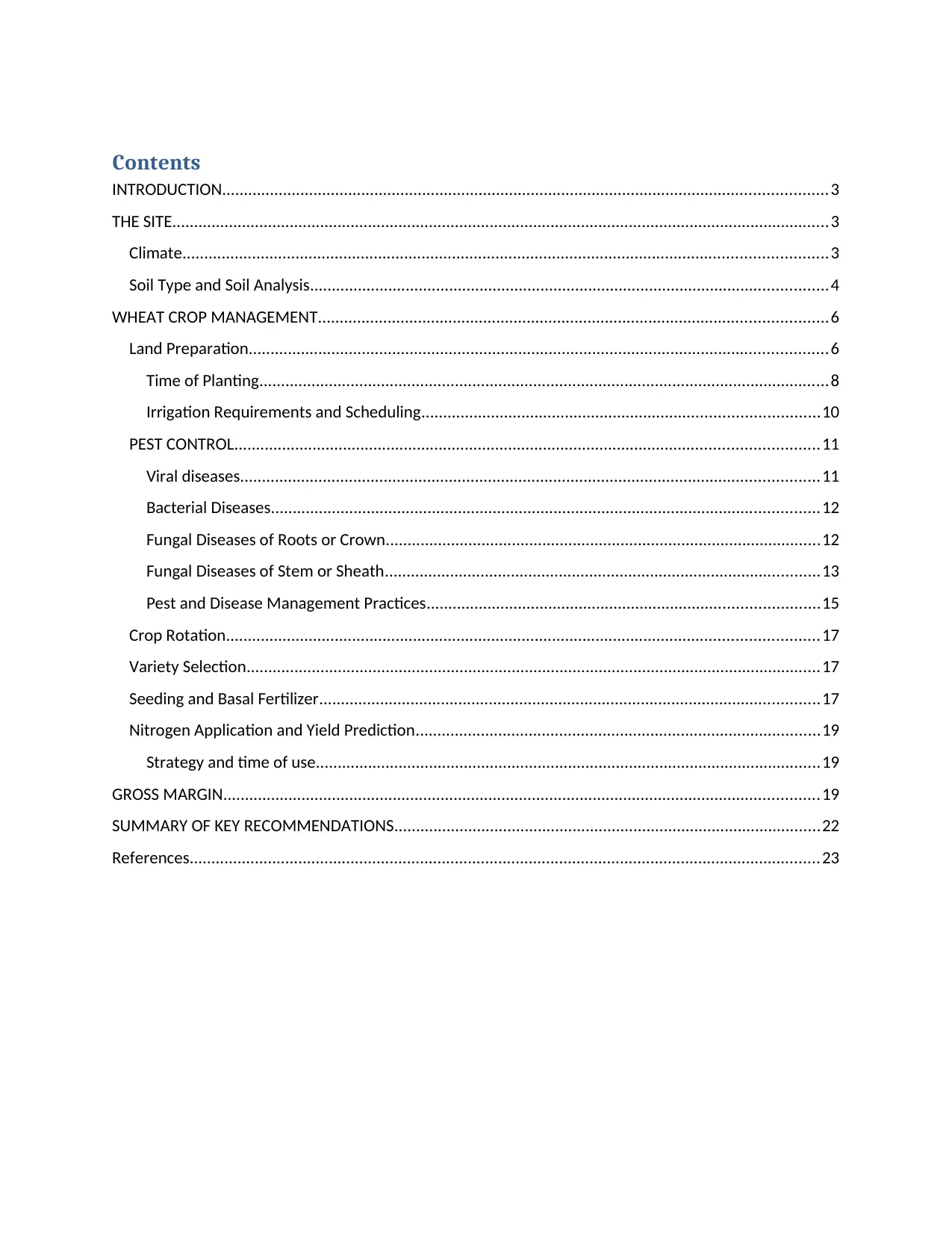
Contents
INTRODUCTION...........................................................................................................................................3
THE SITE.......................................................................................................................................................3
Climate....................................................................................................................................................3
Soil Type and Soil Analysis.......................................................................................................................4
WHEAT CROP MANAGEMENT.....................................................................................................................6
Land Preparation.....................................................................................................................................6
Time of Planting...................................................................................................................................8
Irrigation Requirements and Scheduling...........................................................................................10
PEST CONTROL......................................................................................................................................11
Viral diseases.....................................................................................................................................11
Bacterial Diseases..............................................................................................................................12
Fungal Diseases of Roots or Crown....................................................................................................12
Fungal Diseases of Stem or Sheath....................................................................................................13
Pest and Disease Management Practices..........................................................................................15
Crop Rotation........................................................................................................................................17
Variety Selection....................................................................................................................................17
Seeding and Basal Fertilizer...................................................................................................................17
Nitrogen Application and Yield Prediction.............................................................................................19
Strategy and time of use....................................................................................................................19
GROSS MARGIN.........................................................................................................................................19
SUMMARY OF KEY RECOMMENDATIONS..................................................................................................22
References.................................................................................................................................................23
INTRODUCTION...........................................................................................................................................3
THE SITE.......................................................................................................................................................3
Climate....................................................................................................................................................3
Soil Type and Soil Analysis.......................................................................................................................4
WHEAT CROP MANAGEMENT.....................................................................................................................6
Land Preparation.....................................................................................................................................6
Time of Planting...................................................................................................................................8
Irrigation Requirements and Scheduling...........................................................................................10
PEST CONTROL......................................................................................................................................11
Viral diseases.....................................................................................................................................11
Bacterial Diseases..............................................................................................................................12
Fungal Diseases of Roots or Crown....................................................................................................12
Fungal Diseases of Stem or Sheath....................................................................................................13
Pest and Disease Management Practices..........................................................................................15
Crop Rotation........................................................................................................................................17
Variety Selection....................................................................................................................................17
Seeding and Basal Fertilizer...................................................................................................................17
Nitrogen Application and Yield Prediction.............................................................................................19
Strategy and time of use....................................................................................................................19
GROSS MARGIN.........................................................................................................................................19
SUMMARY OF KEY RECOMMENDATIONS..................................................................................................22
References.................................................................................................................................................23
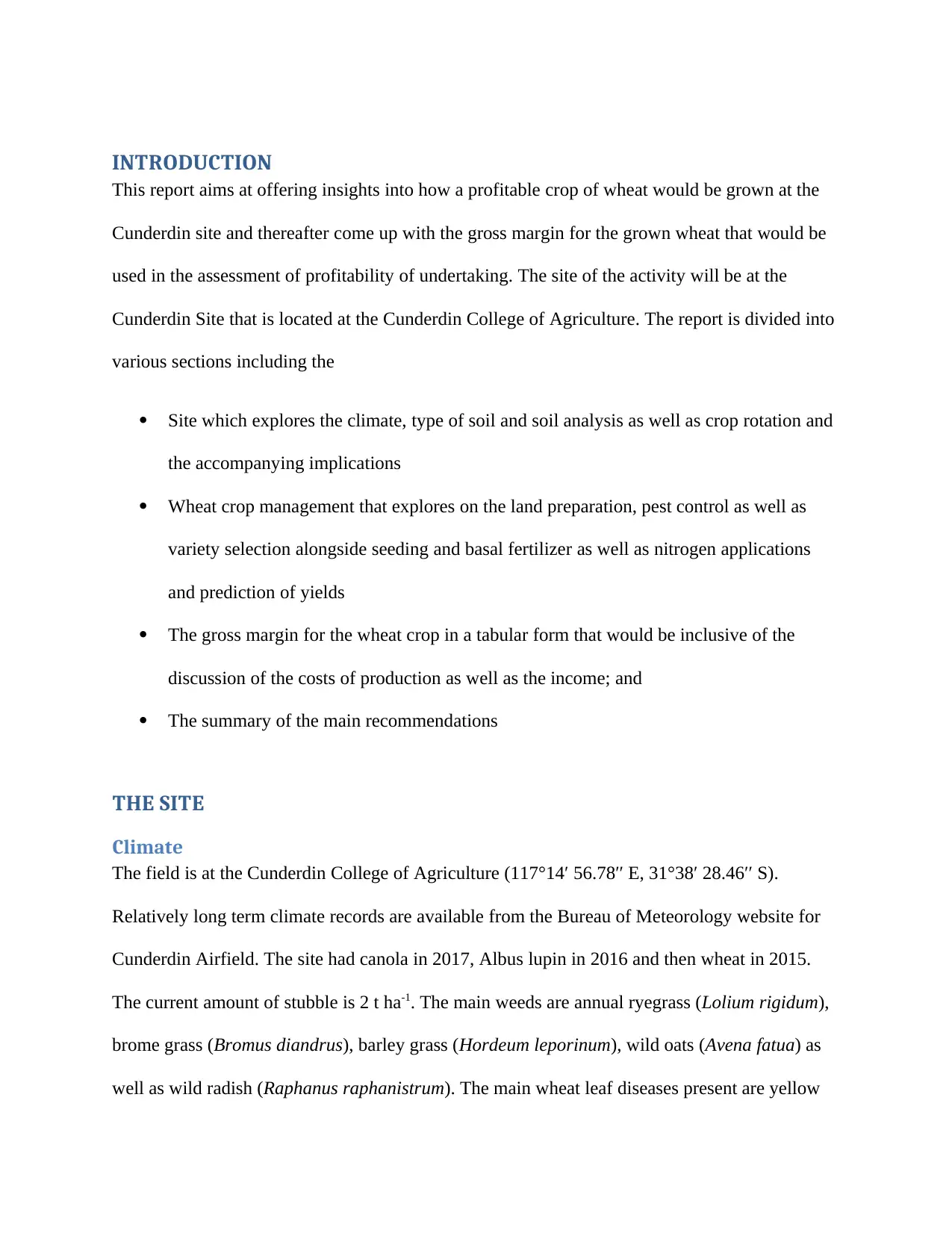
INTRODUCTION
This report aims at offering insights into how a profitable crop of wheat would be grown at the
Cunderdin site and thereafter come up with the gross margin for the grown wheat that would be
used in the assessment of profitability of undertaking. The site of the activity will be at the
Cunderdin Site that is located at the Cunderdin College of Agriculture. The report is divided into
various sections including the
Site which explores the climate, type of soil and soil analysis as well as crop rotation and
the accompanying implications
Wheat crop management that explores on the land preparation, pest control as well as
variety selection alongside seeding and basal fertilizer as well as nitrogen applications
and prediction of yields
The gross margin for the wheat crop in a tabular form that would be inclusive of the
discussion of the costs of production as well as the income; and
The summary of the main recommendations
THE SITE
Climate
The field is at the Cunderdin College of Agriculture (117°14′ 56.78′′ E, 31°38′ 28.46′′ S).
Relatively long term climate records are available from the Bureau of Meteorology website for
Cunderdin Airfield. The site had canola in 2017, Albus lupin in 2016 and then wheat in 2015.
The current amount of stubble is 2 t ha-1. The main weeds are annual ryegrass (Lolium rigidum),
brome grass (Bromus diandrus), barley grass (Hordeum leporinum), wild oats (Avena fatua) as
well as wild radish (Raphanus raphanistrum). The main wheat leaf diseases present are yellow
This report aims at offering insights into how a profitable crop of wheat would be grown at the
Cunderdin site and thereafter come up with the gross margin for the grown wheat that would be
used in the assessment of profitability of undertaking. The site of the activity will be at the
Cunderdin Site that is located at the Cunderdin College of Agriculture. The report is divided into
various sections including the
Site which explores the climate, type of soil and soil analysis as well as crop rotation and
the accompanying implications
Wheat crop management that explores on the land preparation, pest control as well as
variety selection alongside seeding and basal fertilizer as well as nitrogen applications
and prediction of yields
The gross margin for the wheat crop in a tabular form that would be inclusive of the
discussion of the costs of production as well as the income; and
The summary of the main recommendations
THE SITE
Climate
The field is at the Cunderdin College of Agriculture (117°14′ 56.78′′ E, 31°38′ 28.46′′ S).
Relatively long term climate records are available from the Bureau of Meteorology website for
Cunderdin Airfield. The site had canola in 2017, Albus lupin in 2016 and then wheat in 2015.
The current amount of stubble is 2 t ha-1. The main weeds are annual ryegrass (Lolium rigidum),
brome grass (Bromus diandrus), barley grass (Hordeum leporinum), wild oats (Avena fatua) as
well as wild radish (Raphanus raphanistrum). The main wheat leaf diseases present are yellow
⊘ This is a preview!⊘
Do you want full access?
Subscribe today to unlock all pages.

Trusted by 1+ million students worldwide
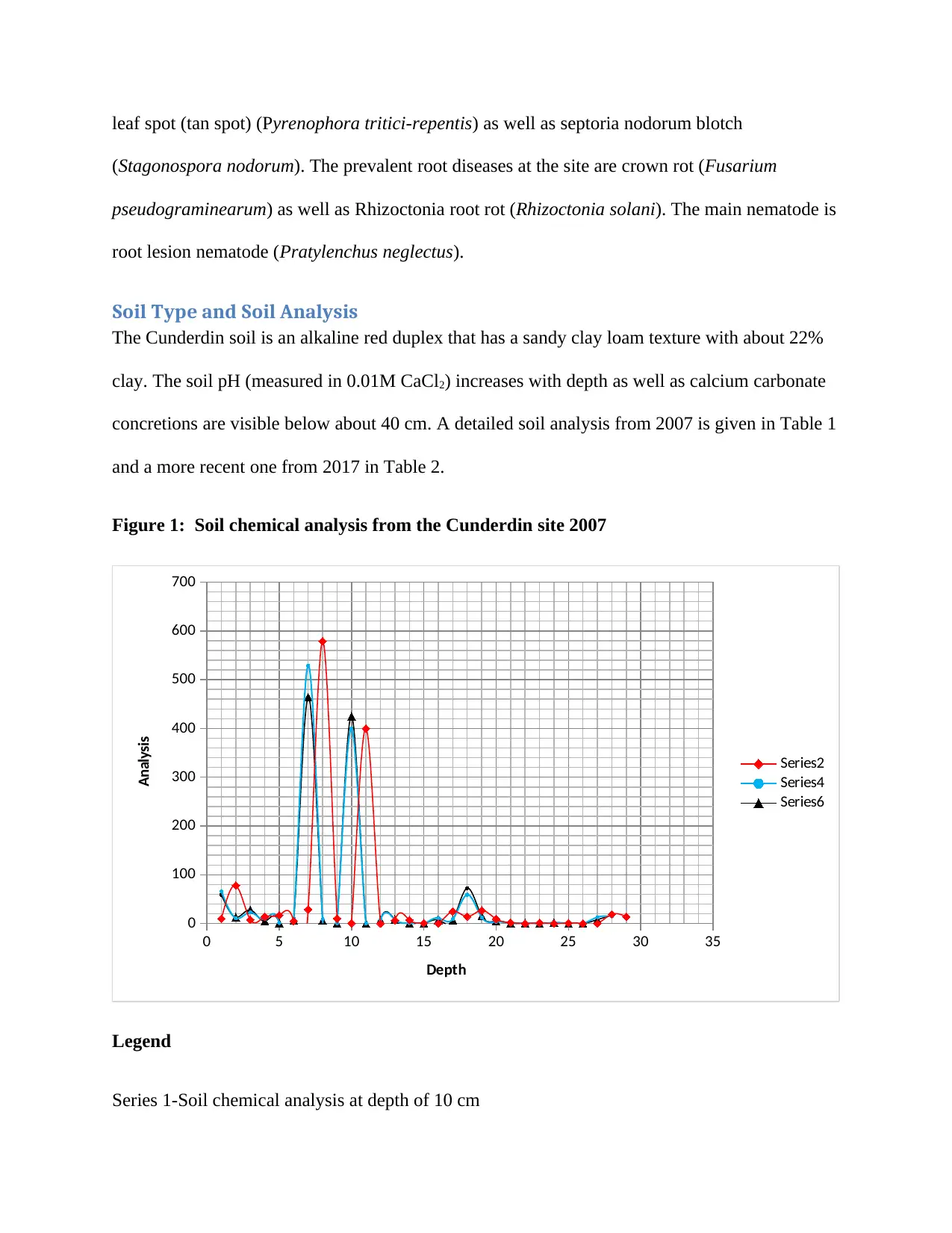
leaf spot (tan spot) (Pyrenophora tritici-repentis) as well as septoria nodorum blotch
(Stagonospora nodorum). The prevalent root diseases at the site are crown rot (Fusarium
pseudograminearum) as well as Rhizoctonia root rot (Rhizoctonia solani). The main nematode is
root lesion nematode (Pratylenchus neglectus).
Soil Type and Soil Analysis
The Cunderdin soil is an alkaline red duplex that has a sandy clay loam texture with about 22%
clay. The soil pH (measured in 0.01M CaCl2) increases with depth as well as calcium carbonate
concretions are visible below about 40 cm. A detailed soil analysis from 2007 is given in Table 1
and a more recent one from 2017 in Table 2.
Figure 1: Soil chemical analysis from the Cunderdin site 2007
0 5 10 15 20 25 30 35
0
100
200
300
400
500
600
700
Series2
Series4
Series6
Depth
Analysis
Legend
Series 1-Soil chemical analysis at depth of 10 cm
(Stagonospora nodorum). The prevalent root diseases at the site are crown rot (Fusarium
pseudograminearum) as well as Rhizoctonia root rot (Rhizoctonia solani). The main nematode is
root lesion nematode (Pratylenchus neglectus).
Soil Type and Soil Analysis
The Cunderdin soil is an alkaline red duplex that has a sandy clay loam texture with about 22%
clay. The soil pH (measured in 0.01M CaCl2) increases with depth as well as calcium carbonate
concretions are visible below about 40 cm. A detailed soil analysis from 2007 is given in Table 1
and a more recent one from 2017 in Table 2.
Figure 1: Soil chemical analysis from the Cunderdin site 2007
0 5 10 15 20 25 30 35
0
100
200
300
400
500
600
700
Series2
Series4
Series6
Depth
Analysis
Legend
Series 1-Soil chemical analysis at depth of 10 cm
Paraphrase This Document
Need a fresh take? Get an instant paraphrase of this document with our AI Paraphraser
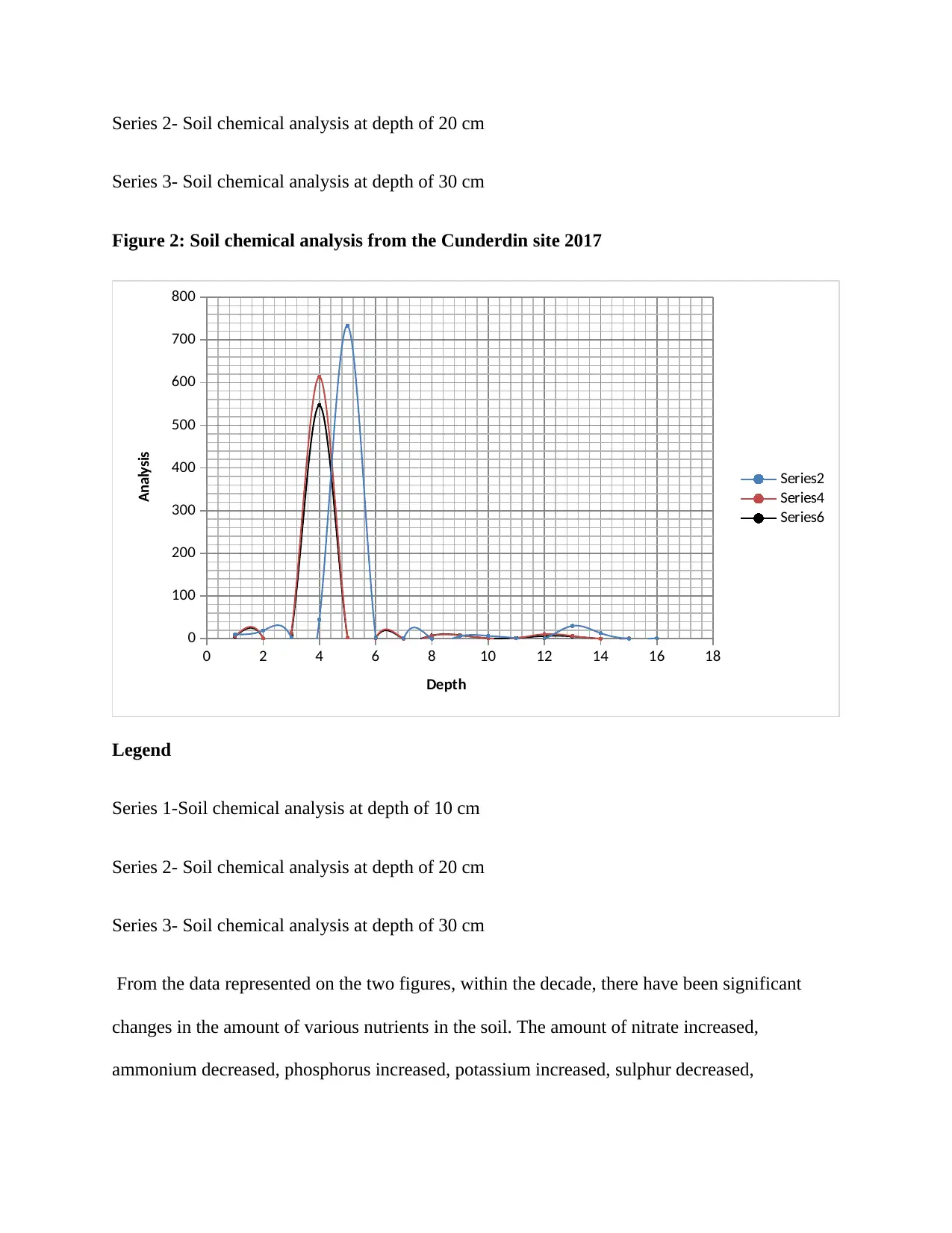
Series 2- Soil chemical analysis at depth of 20 cm
Series 3- Soil chemical analysis at depth of 30 cm
Figure 2: Soil chemical analysis from the Cunderdin site 2017
0 2 4 6 8 10 12 14 16 18
0
100
200
300
400
500
600
700
800
Series2
Series4
Series6
Depth
Analysis
Legend
Series 1-Soil chemical analysis at depth of 10 cm
Series 2- Soil chemical analysis at depth of 20 cm
Series 3- Soil chemical analysis at depth of 30 cm
From the data represented on the two figures, within the decade, there have been significant
changes in the amount of various nutrients in the soil. The amount of nitrate increased,
ammonium decreased, phosphorus increased, potassium increased, sulphur decreased,
Series 3- Soil chemical analysis at depth of 30 cm
Figure 2: Soil chemical analysis from the Cunderdin site 2017
0 2 4 6 8 10 12 14 16 18
0
100
200
300
400
500
600
700
800
Series2
Series4
Series6
Depth
Analysis
Legend
Series 1-Soil chemical analysis at depth of 10 cm
Series 2- Soil chemical analysis at depth of 20 cm
Series 3- Soil chemical analysis at depth of 30 cm
From the data represented on the two figures, within the decade, there have been significant
changes in the amount of various nutrients in the soil. The amount of nitrate increased,
ammonium decreased, phosphorus increased, potassium increased, sulphur decreased,
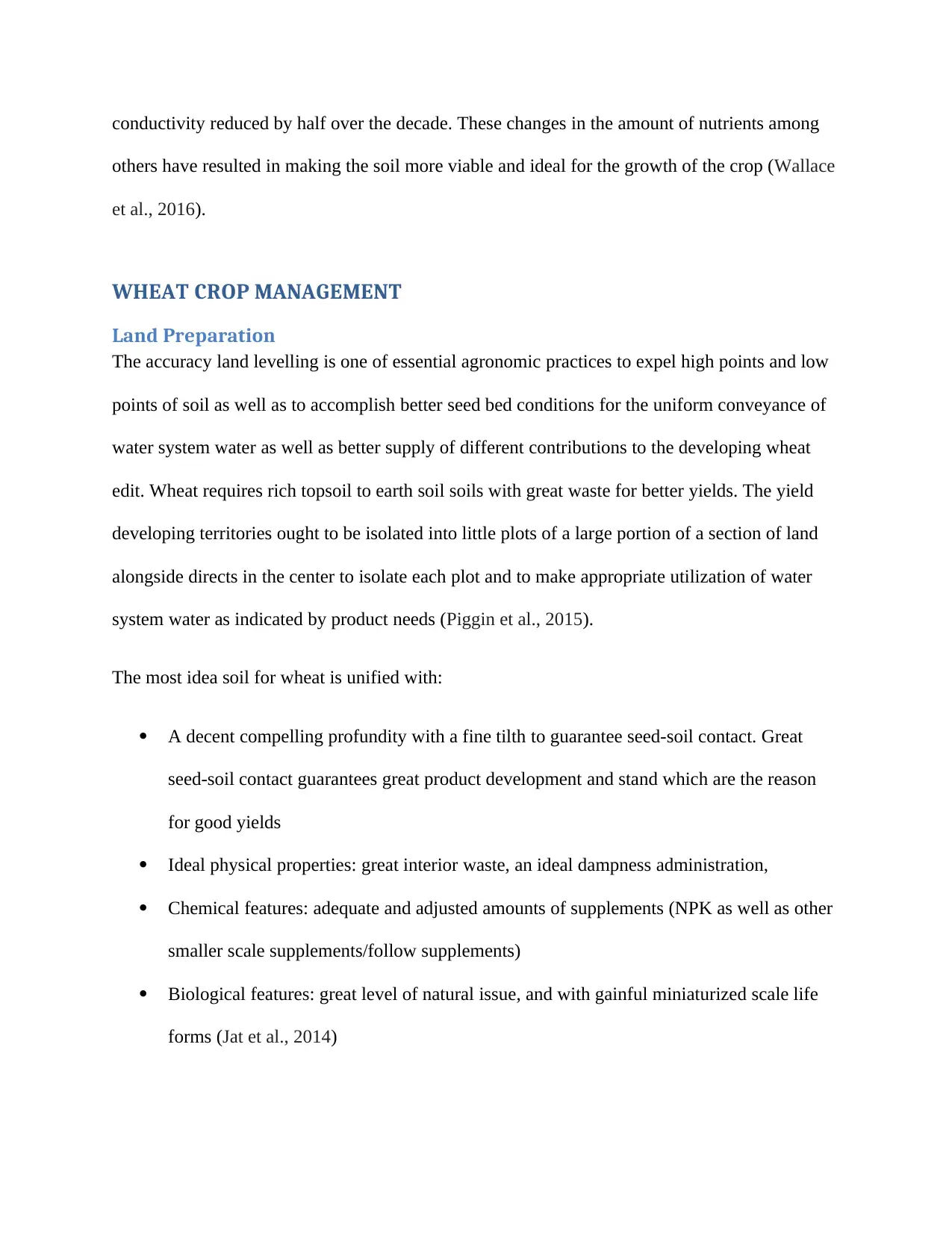
conductivity reduced by half over the decade. These changes in the amount of nutrients among
others have resulted in making the soil more viable and ideal for the growth of the crop (Wallace
et al., 2016).
WHEAT CROP MANAGEMENT
Land Preparation
The accuracy land levelling is one of essential agronomic practices to expel high points and low
points of soil as well as to accomplish better seed bed conditions for the uniform conveyance of
water system water as well as better supply of different contributions to the developing wheat
edit. Wheat requires rich topsoil to earth soil soils with great waste for better yields. The yield
developing territories ought to be isolated into little plots of a large portion of a section of land
alongside directs in the center to isolate each plot and to make appropriate utilization of water
system water as indicated by product needs (Piggin et al., 2015).
The most idea soil for wheat is unified with:
A decent compelling profundity with a fine tilth to guarantee seed-soil contact. Great
seed-soil contact guarantees great product development and stand which are the reason
for good yields
Ideal physical properties: great interior waste, an ideal dampness administration,
Chemical features: adequate and adjusted amounts of supplements (NPK as well as other
smaller scale supplements/follow supplements)
Biological features: great level of natural issue, and with gainful miniaturized scale life
forms (Jat et al., 2014)
others have resulted in making the soil more viable and ideal for the growth of the crop (Wallace
et al., 2016).
WHEAT CROP MANAGEMENT
Land Preparation
The accuracy land levelling is one of essential agronomic practices to expel high points and low
points of soil as well as to accomplish better seed bed conditions for the uniform conveyance of
water system water as well as better supply of different contributions to the developing wheat
edit. Wheat requires rich topsoil to earth soil soils with great waste for better yields. The yield
developing territories ought to be isolated into little plots of a large portion of a section of land
alongside directs in the center to isolate each plot and to make appropriate utilization of water
system water as indicated by product needs (Piggin et al., 2015).
The most idea soil for wheat is unified with:
A decent compelling profundity with a fine tilth to guarantee seed-soil contact. Great
seed-soil contact guarantees great product development and stand which are the reason
for good yields
Ideal physical properties: great interior waste, an ideal dampness administration,
Chemical features: adequate and adjusted amounts of supplements (NPK as well as other
smaller scale supplements/follow supplements)
Biological features: great level of natural issue, and with gainful miniaturized scale life
forms (Jat et al., 2014)
⊘ This is a preview!⊘
Do you want full access?
Subscribe today to unlock all pages.

Trusted by 1+ million students worldwide
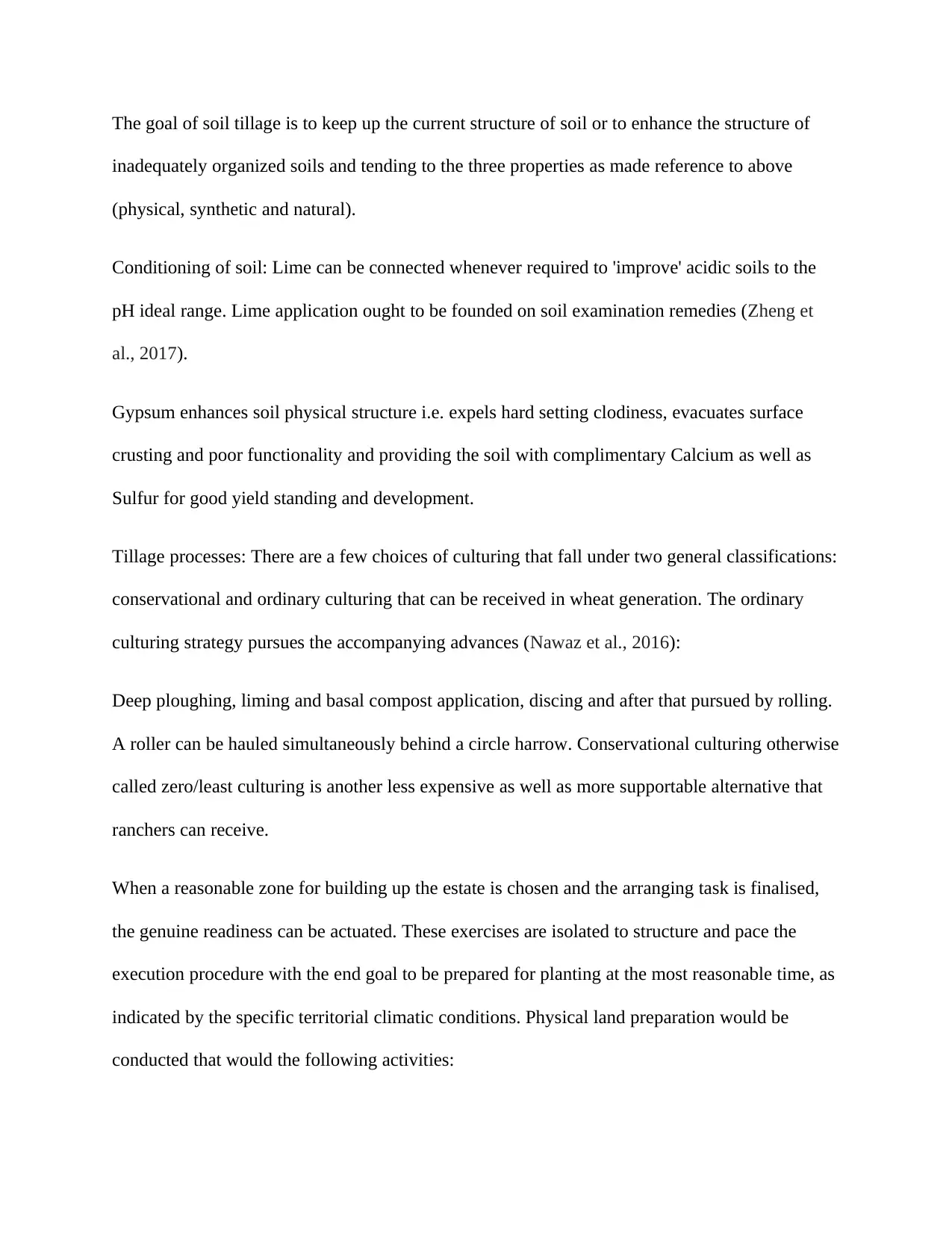
The goal of soil tillage is to keep up the current structure of soil or to enhance the structure of
inadequately organized soils and tending to the three properties as made reference to above
(physical, synthetic and natural).
Conditioning of soil: Lime can be connected whenever required to 'improve' acidic soils to the
pH ideal range. Lime application ought to be founded on soil examination remedies (Zheng et
al., 2017).
Gypsum enhances soil physical structure i.e. expels hard setting clodiness, evacuates surface
crusting and poor functionality and providing the soil with complimentary Calcium as well as
Sulfur for good yield standing and development.
Tillage processes: There are a few choices of culturing that fall under two general classifications:
conservational and ordinary culturing that can be received in wheat generation. The ordinary
culturing strategy pursues the accompanying advances (Nawaz et al., 2016):
Deep ploughing, liming and basal compost application, discing and after that pursued by rolling.
A roller can be hauled simultaneously behind a circle harrow. Conservational culturing otherwise
called zero/least culturing is another less expensive as well as more supportable alternative that
ranchers can receive.
When a reasonable zone for building up the estate is chosen and the arranging task is finalised,
the genuine readiness can be actuated. These exercises are isolated to structure and pace the
execution procedure with the end goal to be prepared for planting at the most reasonable time, as
indicated by the specific territorial climatic conditions. Physical land preparation would be
conducted that would the following activities:
inadequately organized soils and tending to the three properties as made reference to above
(physical, synthetic and natural).
Conditioning of soil: Lime can be connected whenever required to 'improve' acidic soils to the
pH ideal range. Lime application ought to be founded on soil examination remedies (Zheng et
al., 2017).
Gypsum enhances soil physical structure i.e. expels hard setting clodiness, evacuates surface
crusting and poor functionality and providing the soil with complimentary Calcium as well as
Sulfur for good yield standing and development.
Tillage processes: There are a few choices of culturing that fall under two general classifications:
conservational and ordinary culturing that can be received in wheat generation. The ordinary
culturing strategy pursues the accompanying advances (Nawaz et al., 2016):
Deep ploughing, liming and basal compost application, discing and after that pursued by rolling.
A roller can be hauled simultaneously behind a circle harrow. Conservational culturing otherwise
called zero/least culturing is another less expensive as well as more supportable alternative that
ranchers can receive.
When a reasonable zone for building up the estate is chosen and the arranging task is finalised,
the genuine readiness can be actuated. These exercises are isolated to structure and pace the
execution procedure with the end goal to be prepared for planting at the most reasonable time, as
indicated by the specific territorial climatic conditions. Physical land preparation would be
conducted that would the following activities:
Paraphrase This Document
Need a fresh take? Get an instant paraphrase of this document with our AI Paraphraser
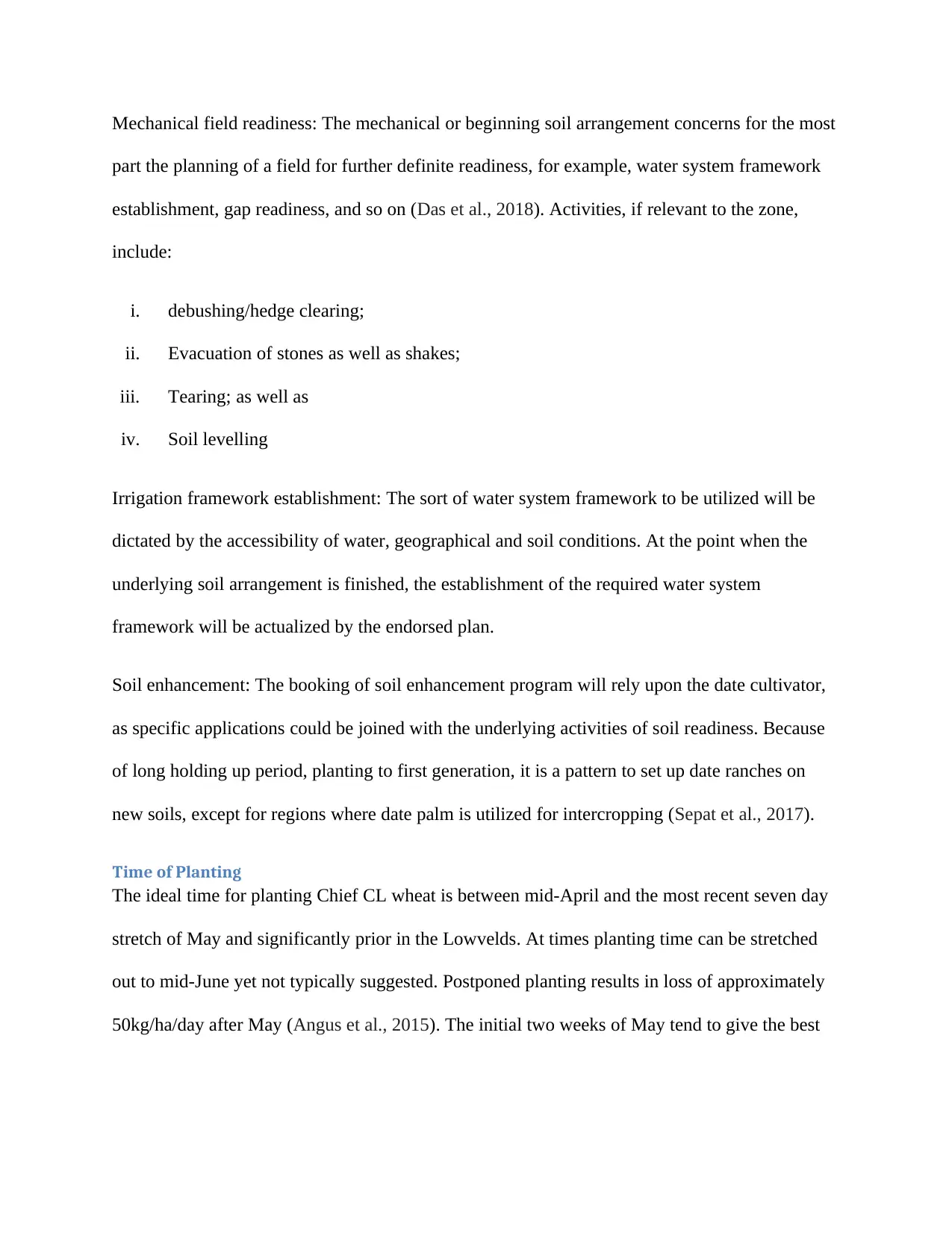
Mechanical field readiness: The mechanical or beginning soil arrangement concerns for the most
part the planning of a field for further definite readiness, for example, water system framework
establishment, gap readiness, and so on (Das et al., 2018). Activities, if relevant to the zone,
include:
i. debushing/hedge clearing;
ii. Evacuation of stones as well as shakes;
iii. Tearing; as well as
iv. Soil levelling
Irrigation framework establishment: The sort of water system framework to be utilized will be
dictated by the accessibility of water, geographical and soil conditions. At the point when the
underlying soil arrangement is finished, the establishment of the required water system
framework will be actualized by the endorsed plan.
Soil enhancement: The booking of soil enhancement program will rely upon the date cultivator,
as specific applications could be joined with the underlying activities of soil readiness. Because
of long holding up period, planting to first generation, it is a pattern to set up date ranches on
new soils, except for regions where date palm is utilized for intercropping (Sepat et al., 2017).
Time of Planting
The ideal time for planting Chief CL wheat is between mid-April and the most recent seven day
stretch of May and significantly prior in the Lowvelds. At times planting time can be stretched
out to mid-June yet not typically suggested. Postponed planting results in loss of approximately
50kg/ha/day after May (Angus et al., 2015). The initial two weeks of May tend to give the best
part the planning of a field for further definite readiness, for example, water system framework
establishment, gap readiness, and so on (Das et al., 2018). Activities, if relevant to the zone,
include:
i. debushing/hedge clearing;
ii. Evacuation of stones as well as shakes;
iii. Tearing; as well as
iv. Soil levelling
Irrigation framework establishment: The sort of water system framework to be utilized will be
dictated by the accessibility of water, geographical and soil conditions. At the point when the
underlying soil arrangement is finished, the establishment of the required water system
framework will be actualized by the endorsed plan.
Soil enhancement: The booking of soil enhancement program will rely upon the date cultivator,
as specific applications could be joined with the underlying activities of soil readiness. Because
of long holding up period, planting to first generation, it is a pattern to set up date ranches on
new soils, except for regions where date palm is utilized for intercropping (Sepat et al., 2017).
Time of Planting
The ideal time for planting Chief CL wheat is between mid-April and the most recent seven day
stretch of May and significantly prior in the Lowvelds. At times planting time can be stretched
out to mid-June yet not typically suggested. Postponed planting results in loss of approximately
50kg/ha/day after May (Angus et al., 2015). The initial two weeks of May tend to give the best
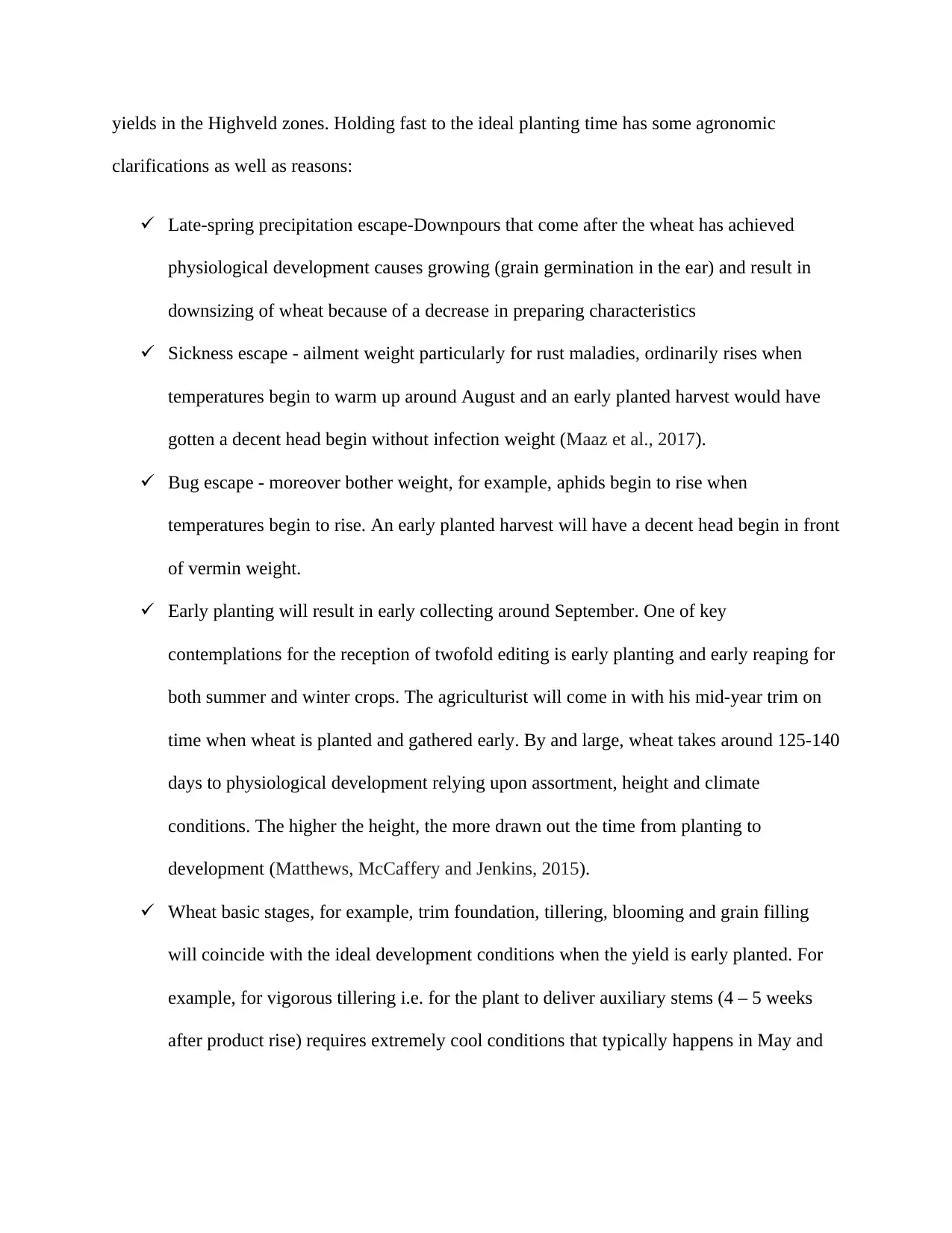
yields in the Highveld zones. Holding fast to the ideal planting time has some agronomic
clarifications as well as reasons:
Late-spring precipitation escape-Downpours that come after the wheat has achieved
physiological development causes growing (grain germination in the ear) and result in
downsizing of wheat because of a decrease in preparing characteristics
Sickness escape - ailment weight particularly for rust maladies, ordinarily rises when
temperatures begin to warm up around August and an early planted harvest would have
gotten a decent head begin without infection weight (Maaz et al., 2017).
Bug escape - moreover bother weight, for example, aphids begin to rise when
temperatures begin to rise. An early planted harvest will have a decent head begin in front
of vermin weight.
Early planting will result in early collecting around September. One of key
contemplations for the reception of twofold editing is early planting and early reaping for
both summer and winter crops. The agriculturist will come in with his mid-year trim on
time when wheat is planted and gathered early. By and large, wheat takes around 125-140
days to physiological development relying upon assortment, height and climate
conditions. The higher the height, the more drawn out the time from planting to
development (Matthews, McCaffery and Jenkins, 2015).
Wheat basic stages, for example, trim foundation, tillering, blooming and grain filling
will coincide with the ideal development conditions when the yield is early planted. For
example, for vigorous tillering i.e. for the plant to deliver auxiliary stems (4 – 5 weeks
after product rise) requires extremely cool conditions that typically happens in May and
clarifications as well as reasons:
Late-spring precipitation escape-Downpours that come after the wheat has achieved
physiological development causes growing (grain germination in the ear) and result in
downsizing of wheat because of a decrease in preparing characteristics
Sickness escape - ailment weight particularly for rust maladies, ordinarily rises when
temperatures begin to warm up around August and an early planted harvest would have
gotten a decent head begin without infection weight (Maaz et al., 2017).
Bug escape - moreover bother weight, for example, aphids begin to rise when
temperatures begin to rise. An early planted harvest will have a decent head begin in front
of vermin weight.
Early planting will result in early collecting around September. One of key
contemplations for the reception of twofold editing is early planting and early reaping for
both summer and winter crops. The agriculturist will come in with his mid-year trim on
time when wheat is planted and gathered early. By and large, wheat takes around 125-140
days to physiological development relying upon assortment, height and climate
conditions. The higher the height, the more drawn out the time from planting to
development (Matthews, McCaffery and Jenkins, 2015).
Wheat basic stages, for example, trim foundation, tillering, blooming and grain filling
will coincide with the ideal development conditions when the yield is early planted. For
example, for vigorous tillering i.e. for the plant to deliver auxiliary stems (4 – 5 weeks
after product rise) requires extremely cool conditions that typically happens in May and
⊘ This is a preview!⊘
Do you want full access?
Subscribe today to unlock all pages.

Trusted by 1+ million students worldwide
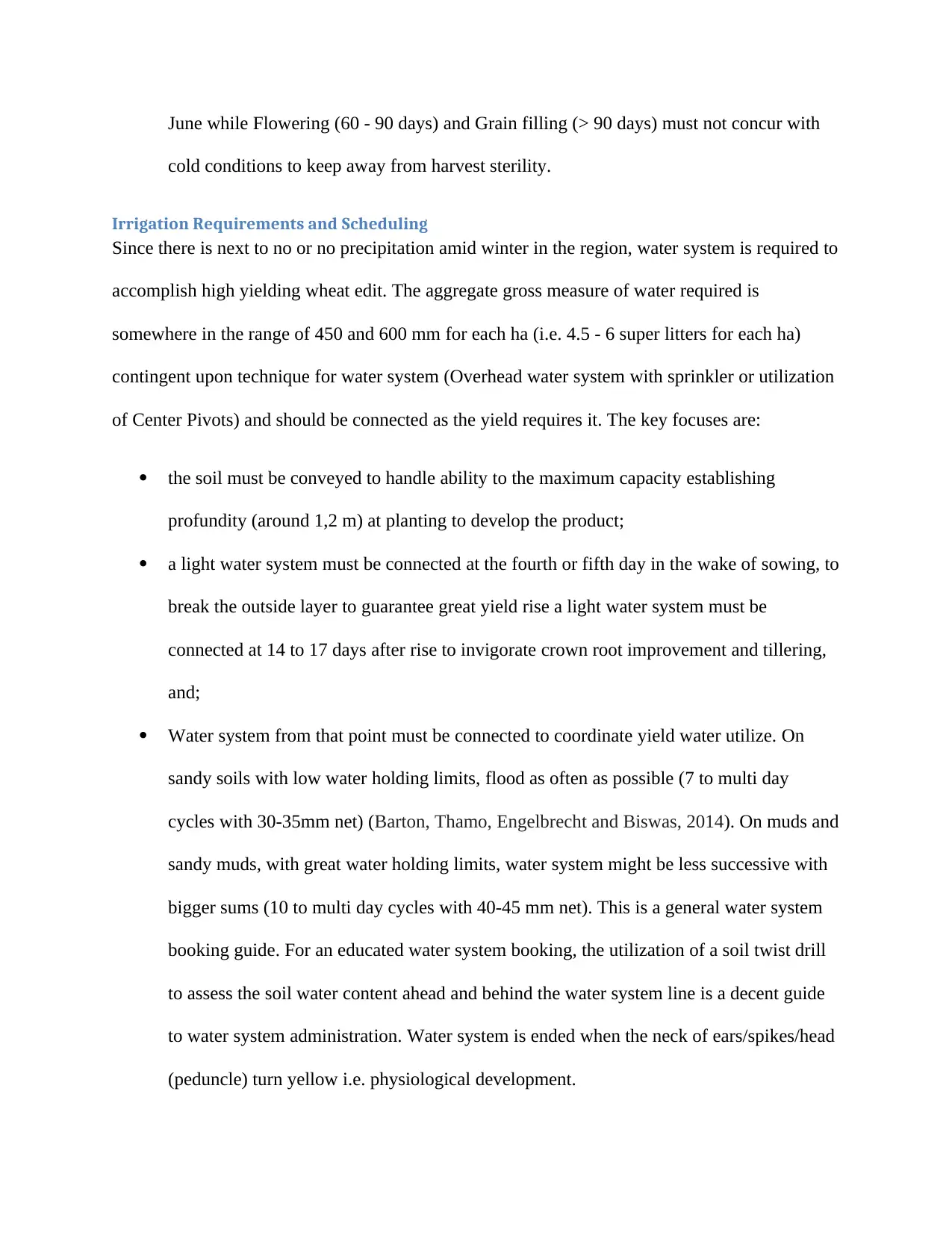
June while Flowering (60 - 90 days) and Grain filling (> 90 days) must not concur with
cold conditions to keep away from harvest sterility.
Irrigation Requirements and Scheduling
Since there is next to no or no precipitation amid winter in the region, water system is required to
accomplish high yielding wheat edit. The aggregate gross measure of water required is
somewhere in the range of 450 and 600 mm for each ha (i.e. 4.5 - 6 super litters for each ha)
contingent upon technique for water system (Overhead water system with sprinkler or utilization
of Center Pivots) and should be connected as the yield requires it. The key focuses are:
the soil must be conveyed to handle ability to the maximum capacity establishing
profundity (around 1,2 m) at planting to develop the product;
a light water system must be connected at the fourth or fifth day in the wake of sowing, to
break the outside layer to guarantee great yield rise a light water system must be
connected at 14 to 17 days after rise to invigorate crown root improvement and tillering,
and;
Water system from that point must be connected to coordinate yield water utilize. On
sandy soils with low water holding limits, flood as often as possible (7 to multi day
cycles with 30-35mm net) (Barton, Thamo, Engelbrecht and Biswas, 2014). On muds and
sandy muds, with great water holding limits, water system might be less successive with
bigger sums (10 to multi day cycles with 40-45 mm net). This is a general water system
booking guide. For an educated water system booking, the utilization of a soil twist drill
to assess the soil water content ahead and behind the water system line is a decent guide
to water system administration. Water system is ended when the neck of ears/spikes/head
(peduncle) turn yellow i.e. physiological development.
cold conditions to keep away from harvest sterility.
Irrigation Requirements and Scheduling
Since there is next to no or no precipitation amid winter in the region, water system is required to
accomplish high yielding wheat edit. The aggregate gross measure of water required is
somewhere in the range of 450 and 600 mm for each ha (i.e. 4.5 - 6 super litters for each ha)
contingent upon technique for water system (Overhead water system with sprinkler or utilization
of Center Pivots) and should be connected as the yield requires it. The key focuses are:
the soil must be conveyed to handle ability to the maximum capacity establishing
profundity (around 1,2 m) at planting to develop the product;
a light water system must be connected at the fourth or fifth day in the wake of sowing, to
break the outside layer to guarantee great yield rise a light water system must be
connected at 14 to 17 days after rise to invigorate crown root improvement and tillering,
and;
Water system from that point must be connected to coordinate yield water utilize. On
sandy soils with low water holding limits, flood as often as possible (7 to multi day
cycles with 30-35mm net) (Barton, Thamo, Engelbrecht and Biswas, 2014). On muds and
sandy muds, with great water holding limits, water system might be less successive with
bigger sums (10 to multi day cycles with 40-45 mm net). This is a general water system
booking guide. For an educated water system booking, the utilization of a soil twist drill
to assess the soil water content ahead and behind the water system line is a decent guide
to water system administration. Water system is ended when the neck of ears/spikes/head
(peduncle) turn yellow i.e. physiological development.
Paraphrase This Document
Need a fresh take? Get an instant paraphrase of this document with our AI Paraphraser
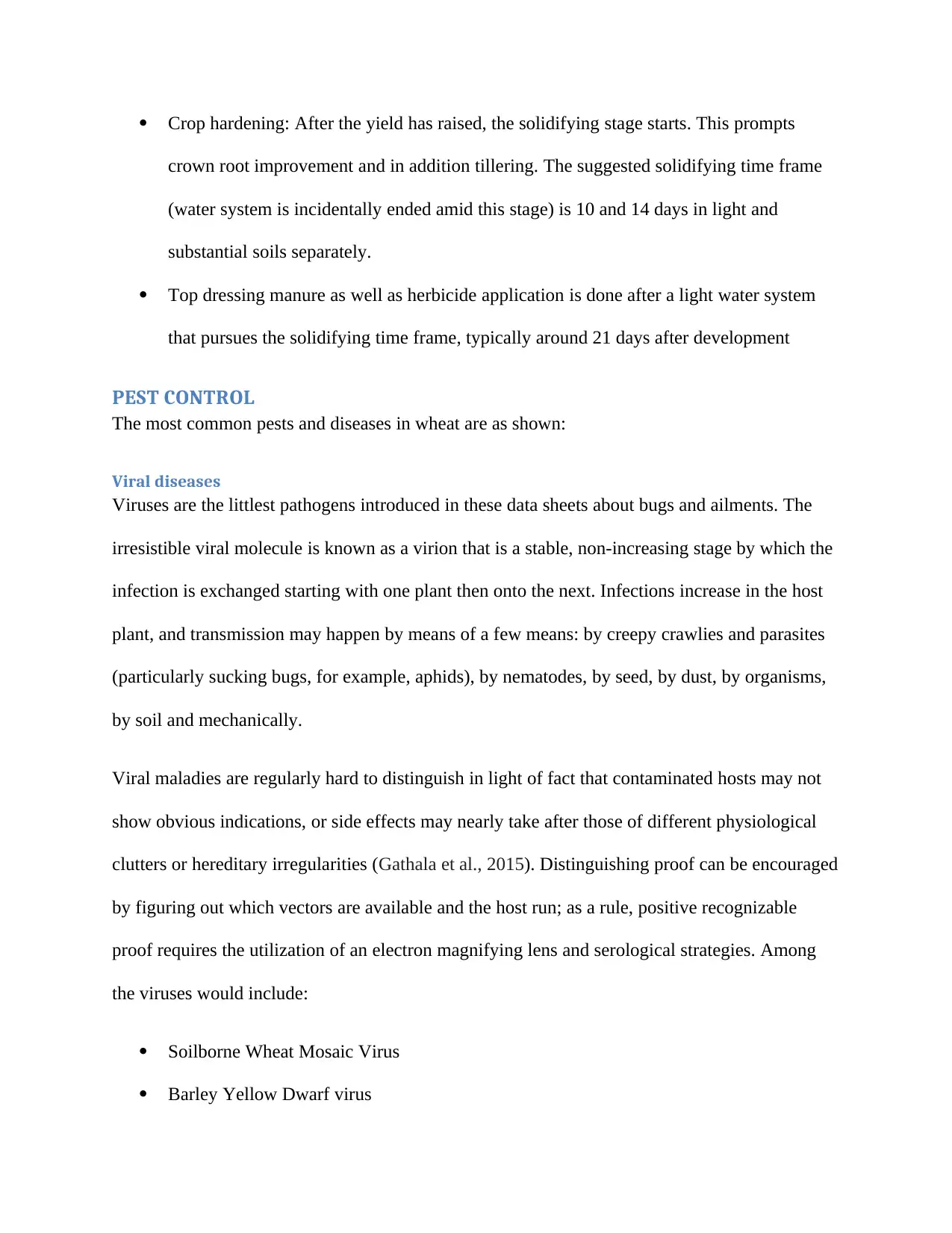
Crop hardening: After the yield has raised, the solidifying stage starts. This prompts
crown root improvement and in addition tillering. The suggested solidifying time frame
(water system is incidentally ended amid this stage) is 10 and 14 days in light and
substantial soils separately.
Top dressing manure as well as herbicide application is done after a light water system
that pursues the solidifying time frame, typically around 21 days after development
PEST CONTROL
The most common pests and diseases in wheat are as shown:
Viral diseases
Viruses are the littlest pathogens introduced in these data sheets about bugs and ailments. The
irresistible viral molecule is known as a virion that is a stable, non-increasing stage by which the
infection is exchanged starting with one plant then onto the next. Infections increase in the host
plant, and transmission may happen by means of a few means: by creepy crawlies and parasites
(particularly sucking bugs, for example, aphids), by nematodes, by seed, by dust, by organisms,
by soil and mechanically.
Viral maladies are regularly hard to distinguish in light of fact that contaminated hosts may not
show obvious indications, or side effects may nearly take after those of different physiological
clutters or hereditary irregularities (Gathala et al., 2015). Distinguishing proof can be encouraged
by figuring out which vectors are available and the host run; as a rule, positive recognizable
proof requires the utilization of an electron magnifying lens and serological strategies. Among
the viruses would include:
Soilborne Wheat Mosaic Virus
Barley Yellow Dwarf virus
crown root improvement and in addition tillering. The suggested solidifying time frame
(water system is incidentally ended amid this stage) is 10 and 14 days in light and
substantial soils separately.
Top dressing manure as well as herbicide application is done after a light water system
that pursues the solidifying time frame, typically around 21 days after development
PEST CONTROL
The most common pests and diseases in wheat are as shown:
Viral diseases
Viruses are the littlest pathogens introduced in these data sheets about bugs and ailments. The
irresistible viral molecule is known as a virion that is a stable, non-increasing stage by which the
infection is exchanged starting with one plant then onto the next. Infections increase in the host
plant, and transmission may happen by means of a few means: by creepy crawlies and parasites
(particularly sucking bugs, for example, aphids), by nematodes, by seed, by dust, by organisms,
by soil and mechanically.
Viral maladies are regularly hard to distinguish in light of fact that contaminated hosts may not
show obvious indications, or side effects may nearly take after those of different physiological
clutters or hereditary irregularities (Gathala et al., 2015). Distinguishing proof can be encouraged
by figuring out which vectors are available and the host run; as a rule, positive recognizable
proof requires the utilization of an electron magnifying lens and serological strategies. Among
the viruses would include:
Soilborne Wheat Mosaic Virus
Barley Yellow Dwarf virus
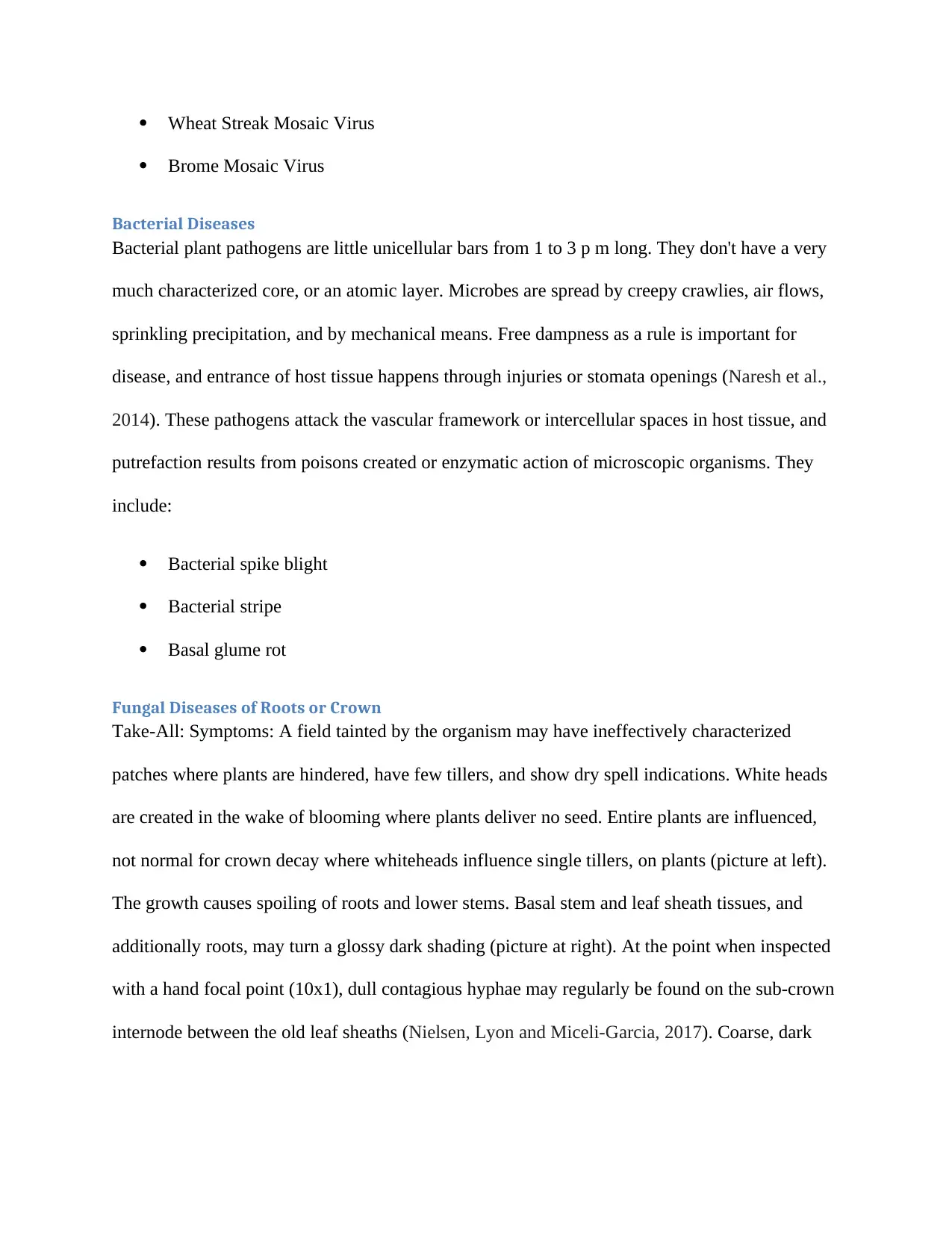
Wheat Streak Mosaic Virus
Brome Mosaic Virus
Bacterial Diseases
Bacterial plant pathogens are little unicellular bars from 1 to 3 p m long. They don't have a very
much characterized core, or an atomic layer. Microbes are spread by creepy crawlies, air flows,
sprinkling precipitation, and by mechanical means. Free dampness as a rule is important for
disease, and entrance of host tissue happens through injuries or stomata openings (Naresh et al.,
2014). These pathogens attack the vascular framework or intercellular spaces in host tissue, and
putrefaction results from poisons created or enzymatic action of microscopic organisms. They
include:
Bacterial spike blight
Bacterial stripe
Basal glume rot
Fungal Diseases of Roots or Crown
Take-All: Symptoms: A field tainted by the organism may have ineffectively characterized
patches where plants are hindered, have few tillers, and show dry spell indications. White heads
are created in the wake of blooming where plants deliver no seed. Entire plants are influenced,
not normal for crown decay where whiteheads influence single tillers, on plants (picture at left).
The growth causes spoiling of roots and lower stems. Basal stem and leaf sheath tissues, and
additionally roots, may turn a glossy dark shading (picture at right). At the point when inspected
with a hand focal point (10x1), dull contagious hyphae may regularly be found on the sub-crown
internode between the old leaf sheaths (Nielsen, Lyon and Miceli-Garcia, 2017). Coarse, dark
Brome Mosaic Virus
Bacterial Diseases
Bacterial plant pathogens are little unicellular bars from 1 to 3 p m long. They don't have a very
much characterized core, or an atomic layer. Microbes are spread by creepy crawlies, air flows,
sprinkling precipitation, and by mechanical means. Free dampness as a rule is important for
disease, and entrance of host tissue happens through injuries or stomata openings (Naresh et al.,
2014). These pathogens attack the vascular framework or intercellular spaces in host tissue, and
putrefaction results from poisons created or enzymatic action of microscopic organisms. They
include:
Bacterial spike blight
Bacterial stripe
Basal glume rot
Fungal Diseases of Roots or Crown
Take-All: Symptoms: A field tainted by the organism may have ineffectively characterized
patches where plants are hindered, have few tillers, and show dry spell indications. White heads
are created in the wake of blooming where plants deliver no seed. Entire plants are influenced,
not normal for crown decay where whiteheads influence single tillers, on plants (picture at left).
The growth causes spoiling of roots and lower stems. Basal stem and leaf sheath tissues, and
additionally roots, may turn a glossy dark shading (picture at right). At the point when inspected
with a hand focal point (10x1), dull contagious hyphae may regularly be found on the sub-crown
internode between the old leaf sheaths (Nielsen, Lyon and Miceli-Garcia, 2017). Coarse, dark
⊘ This is a preview!⊘
Do you want full access?
Subscribe today to unlock all pages.

Trusted by 1+ million students worldwide
1 out of 26
Your All-in-One AI-Powered Toolkit for Academic Success.
+13062052269
info@desklib.com
Available 24*7 on WhatsApp / Email
![[object Object]](/_next/static/media/star-bottom.7253800d.svg)
Unlock your academic potential
Copyright © 2020–2025 A2Z Services. All Rights Reserved. Developed and managed by ZUCOL.